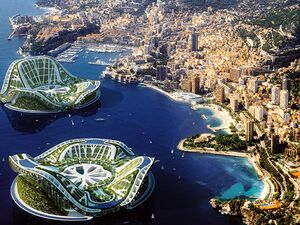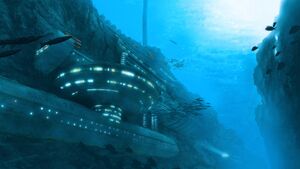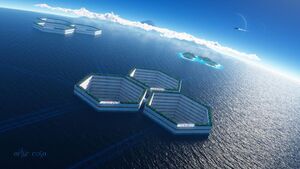Avalon System
More actions
The Avalon System is a star system with five planets orbiting a G-type star, the home to Avalon Fleet Yards. Of these worlds, Avalon II and III are the only ones with permanent populations. There are various Starfleet and Federation facilities spread across the entire system. Two of the terrestrial worlds, Avalon II and Avalon III, have large quantities of heavy water, that is to say water that contains deuterium rather than hydrogen, which makes it an important source of deuterium that can be extracted in much safer and easier conditions than those of the gas giants where it is normally found. In addition, the largest moon of Avalon II, known as Avalon Prime, was a rich source of dilithium for most of this system's colonized history. Deuterium is rare in its natural state, and the current working theory about this system's odd wealth in this substance is that the system was originally a binary system, but the second star failed to fully ignite and eventually its deuterium was drawn to the two worlds during their formation.
Avalon I
Avalon I is a small, semi-molten world orbiting in a nearly-circular orbit .25 AU from Avalon, approximately half the distance between Mercury and Sol. High in iron and other metals, this planet has no atmosphere and little solid landmass, as most of the surface is dominated by rivers and oceans of lava. Starfleet maintains a small network of automated satellites in orbit of Avalon I to study the geology of Class-B planets, and it is also used as a testing area for ships, probes, and other equipment designed to survive in high-temperature environments.
Avalon II
Avalon II is a Class-O pelagic world with 95% of its surface covered in oceans. Highly unusual for a life-supporting planet, the seas of this world are almost entirely composed of heavy water. While toxic to most carbon-based biologies, it is an important source of fuel for anti-matter reactors, and so Avalon II was initially colonized as a refining station. It orbits Avalon at a mean distance of .9 AU, making it slightly warmer than Earth most of its 400-day year. As of the beginning of the 25th century, Avalon II has a permanent population of 50,000 Starfleet personnel, Federation civilians, and nationals from other civilizations, most of whom live in the capital, Sato City. Brahms Station, the Yards' dry docks, and the three Presidium-class stations orbit Avalon II.
Avalon II Surface Facilities
As mentioned above, Avalon II is an ocean world that has large quantities of heavy water. This substance makes the planet an excellent natural fuel source for starships. Floating deuterium refineries bob on the waves around one of the planet's only land masses, which also plays host to the fleet yard's shore facilities. Additional research stations are spread around the planet, both on and under the ocean's surface. There are several dry docks built in shallow areas that allow for the construction and repair of smaller starships capable of planetary landings.
Sato City

Sato City is also home to the Avalon campus of Starfleet Academy, which specializes in providing advanced training to third and fourth-year cadets in engineering. Approximately two-hundred students attend this program at any given time. They live and study in an interconnected dormitory and classroom complex overlooking the ocean.
In-Play
- On a tiny landmass in an otherwise never-ending ocean, Sato City resembles a mediterranean city like Palermo or Malta, with narrow, winding streets. By and large, it is a sleepy residential community, and an excellent place to raise a family. Many of the fleet yards crew have spent a decade or more living and working here, and so the community bonds are tight-knit.
- You're unlikely to find palatable seafood here, as the biology on Avalon II is incompatible with most Federation species—other than Bolians, who consider this to be a culinary mecca.
- For those cadets interested in Engineering, this is a coveted place to finish one's third and fourth years, especially given that one will gain the opportunity to serve one's midshipman cruise aboard the technology testbed USS Edwin H. Armstrong. It's easy to imagine a cruise like this being significantly more exciting than some others—if your idea of excitement is matching wits with an experimental piece of prototype technology!
Deuterium Refineries & Research Stations

There are multiple research stations on Avalon II, studying the planet's unique ecosphere, mineral deposits, and other areas of interest. The higher density of heavy water means that those on the ocean floor must be specially reinforced. These facilities are run by a mix of Starfleet Science offices and civilian Federation agencies. Typically, the scientists on these stations commute between Sato City and their outlying research posts, but some of the most remote stations have their own accommodations.
In-Play
- There are dozens of small facilities spread throughout Avalon II, which means that there are dozens of different settings for stories about underwater science, deuterium refining, and other activities that would make for great interludes from your epic starship stories.
- Every aspect of biological, mineralogical, and planetary sciences would be represented on these outposts.
Ocean Dry Docks

In-Play
- A caisson is a tube that displaces water to allow the floor of a body of water to be exposed to the air. These dry docks are large caissons featuring landing areas for small starships. The view here is slightly more interesting, or at least a little mundane, compared to that of the dry docks in orbit.
- Ships that could make use of these dry docks would be of the Luna class or smaller.
Avalon III
Avalon III is a Class-P ice world that, like Avalon II, is dominated by deuterium-laden water, though on this smaller, colder world, it is all locked up in massive glaciers. Unlike Avalon II, Avalon III is sterile—life was not able to find a way here the same way it was on its sister planet. This planet is home to an Andorian colony, as well as a Federation science station attempting to introduce life-forms from Avalon II onto Avalon III. There are deuterium refineries as well, though the process of mining ice, then melting it, then extracting deuterium is much more energy-intensive and less efficient than doing so from the liquid water on Avalon II. Avalon III's present population is about 10,000. The Yards' original Anchorage-class headquarters station, now designated Station Avalon III, orbits Avalon III to organize outgoing deuterium shipments and support the Andorian colony.
Avalon IV
Avalon IV is a standard Class-J gas giant about the size of Saturn. Like most gas giants, it has plentiful hydrogen reserves. Unlike most of these worlds in Federation space, it has not yet been exploited as a deuterium production facility, as this substance is readily available elsewhere in this system. Starfleet's long-term strategic plan for the system calls for the construction of such a facility by the 26th century, when it is expected that exploitation efforts on Avalon II and Avalon III will begin to lose efficiency. This world has an extensive system of moons, some of which are marginally habitable. In addition, there is a complex ring system. These features are both used to great effect to test new starships' maneuverability and for starfighter pilot drills.
Avalon V
Avalon V, a Class-I ice giant, is at the extreme edge of the Avalon system. Like Avalon IV, it has yet to be exploited. It also has a ring system and many small moons, but none of these moons have achieved the mass to become spherical. Avalon V is home to Research Station Avalon V, a Jupiter-class station tasked with performing dangerous, high-energy experiments and defensive system engineering. Several dozen mothballed starships orbit Avalon V as well.
